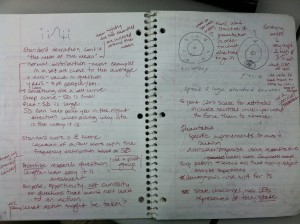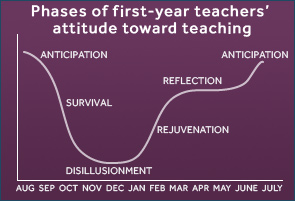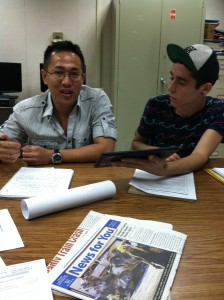To explain how this summer will impact my students, I would like the begin with a story.
For some reason when I first started high school, I got placed in “advanced” math, which moved at a dizzying pace (I have a theory that kids who excel at certain parts of school are just assumed to excel at ALL parts of school, and so are placed ipso facto into solid advanced classes). All I could think to do was write down every word the teacher said, but none of it made any sense when it came time to do my homework. After a few weeks of this, I began to get extremely anxious about math class. How could I ask questions if I had no idea what was going on? During tests, all the studying I did somehow did not seem to apply to even one test question. (A now-hilarious and then-miserable memory: memorizing the acronym SOHCAHTOA for a geometry test, forgetting it all during the test and thinking that no, it was supposed to be SACAGAWEA, and spending the rest of the time trying to figure out what SACAGAWEA stood for.)

SohCahToa graphic designed by teacher Luke Miller. This still makes 0% sense. Please do not try to explain it to me; I am an adult and I celebrate that nobody can make me learn it anymore.

Sacagewea, from the U.S. Postal Service. She does not look like a math equation.
Fortunately, I was switched down into the “standard” class, which I did fine in because the tests were exactly like the study guide, we got graded on the completeness of our notes, and I was one of the only people in class who actually paid attention instead of being weird (the guy who sat behind me tried to bite my neck once???) and/or disruptive and/or sleeping. However, the anxiety remained.
Due to my very different humanities and music brain, by senior year I had a whole semester’s worth of AP college credit and some music and academic scholarships. But one thing stood between me and the colleges I wanted to go to: completing the PRECALCULUS REQUIREMENT. After much sorrow and gnashing of teeth, a tiny note from my teacher appeared on my yet another 0% quiz: “re-take at home.” Relieved, I took it home, sat at the kitchen table, and realized I could breathe and think again. I passed the quiz. With the individual help of my teacher and the math tutor he suggested my parents get for me, I ended up passing the class. Now, I would never let kids takes tests home to re-take them, but I think my teacher did that because he was creating a kind of post hoc separate-setting accommodation that I might have received on a 504 if I was attending school now.
So now flash forward to this summer: even as an adult, the thought of math–even seeing a bunch of numbers on a board!– makes my chest feel tight, and I have stayed as far away from it as possible. Imagine my surprise when—and I still have no idea how this ended up happening—my Kenan project has ended up being completely research-based. I consulted with a statistician in the department (who has awesomely become like my second mentor) who made it clear that in order to turn the results into something valid and meaningful, there would have to be statistical analysis. Immediately I got that familiar chest-tightening feeling.
I began to work through some introductory statistics online tutorials, and I realized something. Everything I learned I actually understood because I was constantly working out how I could apply it to my actual research project. For the first time in my life, Standard Deviation made sense because I knew how I would use it and why it would be effective.

My fellowship notebook, including lots of notes on the statistics I need to understand for my project. This is the exact stuff that, in my bottom-of-the-barrel “Numeracy for Humanities Majors”–seriously, that’s what it was called–class I took in college, made me tear up while handing in my final exam, making the professor extremely uncomfortable.
Math made sense and it did not cause me anxiety because it wasn’t a random word problem my textbook was torturing me with at 3 a.m.; it was something I was applying at every single step.
This made me think about my students who probably get that tightening in their chest when they think about reading and/or writing. I have had many students tell me that my class was the first English class they ever succeeded in, and the first class where they made it to the end of a book. I think this is because I structure my class in a way that I hope makes them comfortable enough to believe they can do it: I rely on predictability in grading, homework, and classroom routines; scaffolding tougher material while throwing in some stuff they already feel confident doing; and a ton of encouragement.
But during our transition to Common Core (and all through our Kenan professional development this summer!) I keep hearing: change the routine! Minimal direct instruction! Put your students in UNCOMFORTABLE SITUATIONS where they have to GRAPPLE with the material! Um, my struggling readers are in an uncomfortable situation whenever they open their books; is my goal really to make them MORE uncomfortable?
However, finally being successful in math by learning through application made me think that perhaps there IS a way to introduce tough material with less direct instruction to struggling students and making them—if not “uncomfortable”—at least placed in situations where they are having to deal with a brand-new challenge. If we deviated sometimes from the background lecture-read-analyze-activity-assessment cycle of the traditional English class, if we helped students through independent and group applications to create something they find meaningful, connected to the world, and non-arbitrary….could that make the same difference for some kids as this made for me?
I wish part of all this was realizing exactly how to DO that with my students, but I guess that would be too easy! I dunno….do you all have any ideas? School’s going to start before we know it!









